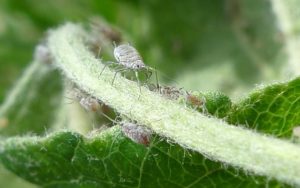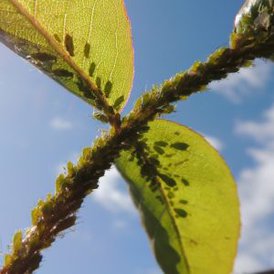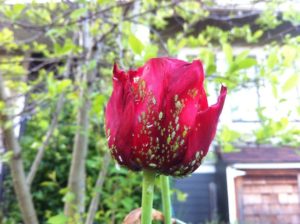When you see something a little off about your tree, you may want to look a little closer, because it could be something quite small catching your eye. There are many signs of an aphid infestation, including leaves dripping sap, fuzzy gatherings on your branches, or occasional browning. These are aphids, pesky insects that can lead to the death of your trees due to stress or another disease.
1. What are Tree Aphids?

- Insects that can be any number of colors
- Traditionally all the same color
- Leech nutrients from the tree
Aphids are tiny, soft-bodied insects that you will spot on your trees. They sit on tree foliage and shoots, sucking on the fluid from the tree. In general, most aphids do not have wings, but there are some species that do, although they are rare. You may see some with wings when you have an extremely large population in the late spring or fall. These winged individuals are a benefit to the colony because they can spread to other plants, growing the population and creating a new home for when the food source deteriorates.
They are taking the nutrients and water from the tree, slowly killing it. You will most likely find them in clusters, usually on the undersides of the leaves. As they feed, they will secrete a sticky fluid called the “honeydew.” You may see this on the leaves and think it is a sap. If there are enough, you will be able to spot it from a distance. You should also know that they do not move quickly or at all when they are approached, so if you only find a few, you may be able to simply pick them off. However, if they have wings, you may want to look at some of your other plants.
When left alone, honeydew “…may cover leaves, branches, sidewalks, and anything that lies beneath an infested plant material. Grayish sooty mold grows on the honeydew, further detracting from plant appearance. Ants, yellow-jacket wasps, flies, and bees are usually attracted to plants that are covered with honeydew,” according to Colorado State University.
2. Why Do Aphids Cause Problems?

- Open up portals for disease
- Can bring in other infestations
- The tree cannot get enough nutrients
The main problem with aphids is that they can carry and spread fungal diseases, which can completely decimate trees, especially those that are young or already weak. If the infestation gets to be too much, it can kill and/or seriously damage the tree. To prevent the spread of disease due to an aphid infestation, you want to work on eliminating both risks at the same time.
Before the infestation even comes, you want to keep your tree as healthy as possible. This will make it much hardier if an infestation does come.
To spot the problem, you may notice misshapen, yellowing, or curling leaves, especially on the undersides. The stems could be yellow or covered in a sticky substance, according to Almanac. The flowers or fruit that grow on those trees can also be misshapen. Of course, you may also notice other insects coming to the tree, including flies, lady bugs, and borers or all kinds.
3. Tree Aphid Treatment

- Control ants that feed on honeydew
- Be careful what chemicals you use
- Contact a professional
Treating a tree aphid problem can be difficult. You want to start by controlling the ants that eat the honeydew, which can actually be a bigger problem. Ants protect those aphids from their natural enemies, making this something that won’t sort itself out easily. You may be able to set traps, but they can be dangerous to children, pets, and any other wildlife that comes into contact with them. If you kill too many of the natural predators, you can create an even bigger problem.
Beneficial insects can be upset by the use of strong insecticides and make the infestation much worse. You may be able to use spray or some DIY techniques, but you have to be careful that you don’t disrupt the ecosystem. Sometimes it can take a few treatments to get all of the aphids off of the tree, even with professional intervention.
One of the best treatments is simply prevention. The Tree Center suggests this to avoid it: “Any time you bring in a new plant check it carefully before you take it anywhere near your garden. Look for feeding aphids, and also check underneath the leaves for egg clusters. Aphid eggs are tiny, but they lay them in bunches so they should be visible as small white flecks. If the plant turns out to be heavily infested it’s best to get rid of it. A few aphids can be dealt with, but you need to be thorough or the result could be a disaster for your whole garden. If you have any doubts at all treat the plant before introducing it.”
The best thing to do if you see a problem like an infestation is to reach out to a professional. They will be able to use tools that are equally effective and safe. We know the right chemicals that will pose the least amount of danger to your family, other plants, and the trees themselves. Time is of the essence: it is much easier to eliminate the problem if we are able to catch it early. Do not hesitate to snap a few pictures and ask what they are – it is better to be safe rather than sorry.
If you are worried about your trees or you see something that just doesn’t look right, make sure to give Arbortec Tree Service a call at (303) 466-3175. While you can certainly watch over your trees and love them, there is nothing that beats the practiced hand of professionals. We can help you to take care of your fruit trees so that you get the best possible yields (and the tastiest).
